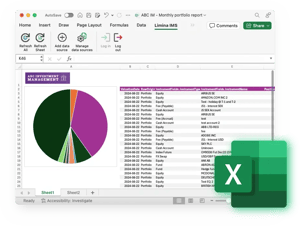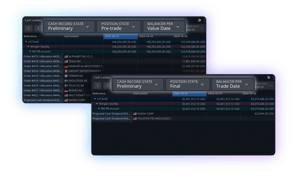
Family Office Software: Reporting, Consolidation & Risk Oversight
When evaluating options, we recommend not to rely too much on online family office software reviews. Most review site placements online are, unfortunately, fake or bought (affiliate / pay-per-click). This article gives you the information you need to do your own family office software comparison.
We’ll use the following acronyms in this article:
- Family Office (“FO”)
- Family Office SoftWare (“FO-SW”)
Core capability 1: Reporting software
Reporting is often listed as a component of a FO system, but rarely explained. Reporting on what?
Here are a few examples of what the best family office reporting software should cover:
- Investment performance reports, both absolute returns (contribution) and attribution (compared to benchmark)
- Total wealth reports
- Exposure and allocation reports, incl. look-through
- Fee and cost reports

Reporting software can be standalone or part of a broader family office management software. The best approach is to have ONE platform for all your requirements. That platform manages all dataflows, quality controls and investment workflows. Reporting becomes a simple task of extracting what’s in the platform.
Limina can usually replace multiple systems; contact us if you’d like to learn more about how.
Dashboards & mobile app
Providing family members with direct access to a dashboard in a mobile app is a great way to reduce the reliance on PDF reports. The modern experience that clients rightfully expect today is being able to log in whenever they want and see the data they need. By choosing the right family office software solutions, you can offer a mobile app with data security managed by the software vendor.

Core capability 2: family office data aggregation
Family office software and data aggregation have almost become synonyms. It’s important to differentiate the two:
1. The FO-SW has functional capabilities like reporting, investment tracking, cash projections, etc.
2. The data aggregation capabilities connect to custodians, market data, and other data sources to ingest data into the platform.
The best family office software has both in one system and automates as much as possible.
Configurable import/export application
A prerequisite for data aggregation is getting data in and out of the system. Most existing family office software vendors will build a connection to each data source (for example, each custodian) and maintain that connection.
This solution has many issues:
- It’s limited to the data sources (custodians, data vendors, etc) that the software vendor has built connections to
- It’s limited to the data that the vendor has chosen to integrate (it might, for example, not include ESG data that is critical to you)
- Connections typically come with a fee (for example, charged per custodian or connections)
At Limina, we take a radically different approach. We allow you to set up a new connection in 3 minutes to or from any custodian (or any other data source). This groundbreaking approach to connectivity is free of charge and is always included in the base subscription. Watch a video of the import/export application here.
Data aggregation: never import cash balances or positions
Most FO-SW will import cash balances from custody. Importing cash balances is a problematic approach because information is lost; you don’t know what has gone into the balance and what hasn’t.
The better approach is to import all cash movements, such as expenses, income, transfers, etc. That way, the FO-SW calculates the cash balance, including its preexisting knowledge about transactions, fees, taxes, investments and accruals. With cash balances calculated (instead of imported), you can reconcile the cash balance and spot any errors at the custodian. The reconciliation also increases governance.

The other benefit of importing cash movements is that you retain simulation capabilities. The system can then simulate cash fully into the future, knowing what has settled at the custodian and what hasn’t. Without this knowledge, a cash simulation will be uncertain.
Software for family offices: other functional capabilities
An end-to-end family office investment management software has capabilities beyond reporting and data aggregation. Here are 5 additional capabilities to look for when reviewing family office software:
Family office investment tracking software aims to enable informed investment decisions and risk management. To that end, the FO-SW allows portfolios to be slice’n’diced on any set of standard and custom parameters. For example, aggregating on industry or even company level, including look-through (such as if the same company held through multiple VC funds).
Real-time market data is an optional connection for listed investment portfolios, although rarely used, since it introduces noise and distractions.
Projecting cash flows means the ability for the FO-SW to show:
- Settlement date cash, i.e. when cash moves from bank accounts
- Trade date cash, i.e. the date when a contractual cash commitment happens – for example, on the trade date for a hedge fund investment regardless of settlement lag (can be days, weeks, months and differ between sell and buy)
- Committed capital, capital calls, etc for PE/VD-fund investments
Family office investment software allows you to simulate changes in the portfolio, such as changing the asset allocation.
Once a rebalancing is satisfactory, some FO-SW allows you to send orders. For exchange-traded assets, it can mean routing directly to brokers. Mutual funds are often possible to trade electronically as well. The process is highly manual for alternative assets, land, art, etc., and the FO-SW’s job is to track each possible investment’s state through its lifecycle.
Family office portfolio management software can support 3 approaches to accounting:
- Connect to a separate accounting system
- Connect to a fund administrator
- Have a built-in sub-ledger
Multi-family office software capabilities
The difference between single-family office software and a multi-family office platform is relatively small, especially if the multi-family office operates as a pooled fund vehicle. The multi-FO software must support more complex permissions, especially if the software allows family members to log in to see dashboards and take actions. In case a multi-FO does not pool the capital (and instead invests on behalf of each family member separately), there may also be a need for multi-portfolio rebalancing and order management capabilities.
While regulatory compliance isn’t mandated for FOs, a multi-family office might have discussions about limit control and investment restrictions with each family. In some family office platforms, you can enter their rules and the platform will report on compliance and warn you if any breach has occurred or is about to occur, according to your preferences.
Asset class coverage of family office solutions
As FOs invest in a wide range of asset classes, it’s essential for a system to support all possible investment strategies. This includes private assets, not just PE funds but also assets like land and art.
Hedge funds and other fund investments should ideally support look-through, both on a constituent level (when you have access to this data) and on a factor level (for example, “20% industrials in Europe”).
Explore a Better Family Office Solution
Get all your reporting, dashboards, data aggregation and automation in one system.







